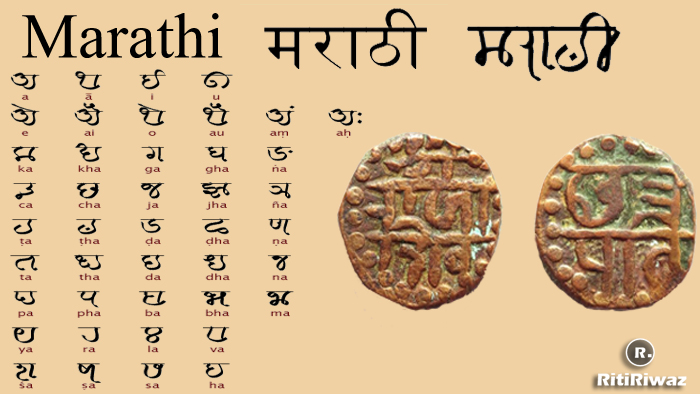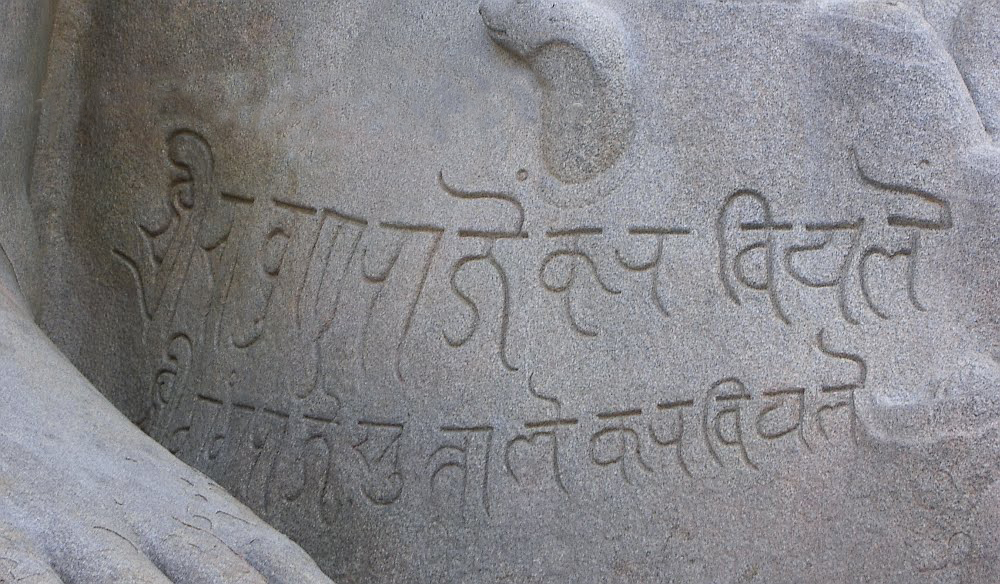Marathi Language (मराठी)

Marathi is one of the Indo-Aryan languages and is one of the top languages of India. It is the official language in the states of Maharashtra and the co-official language in the union territories of Daman and Diu and Dadra and Nagar Haveli. In Goa, Konkani is the sole official language; however, Marathi may also be used for some official purposes in some cases.
According to the population of Marathi’s mother tongue, it is the language spoken by 90 million people, Marathi is the fifteenth in the world and the fourth language in India. Marathi has some oldest literature of all modern Indian languages, dating back to around 600 AD. The main dialects of Marathi are Standard Marathi and the Varhadi dialect. It descends from the middle Indo Aryan Maharastri, the most literacy of the vernacular language known as Prakrits. It has also been influenced by Kannada and Telugu, two neighboring Dravidian languages.
In addition to all universities in Maharashtra, the Maharaja Sayajirao University of Baroda in Vadodara, Osmania University in Hyderabad, Karnataka University in Dharwar, Gulbarga University in Gulbarga, Devi Ahilya University in Indore, and Goa University in Goa have special departments for higher studies in Marathi linguistics.
Jawaharlal Nehru University (New Delhi) has announced plans to establish a special department for Marathi. Marathi distinguishes inclusive and exclusive forms of ‘we’ and have a three-way gender system (pretty rare worldwide!) that features the neuter in addition to the masculine and the feminine. The Modi script was used to write the Marathi language spoken in the Indian state of Maharashtra. It originated as a cursive variant of the script during the 17th century CE. Modi was used until the 1950s when Devanagari replaced it as the written medium of the Marathi language.
History of Marathi Language
Marathi Language during prehistoric times was also called Maharashtri, Marhatti, Mahratti, etc. Marathi literature was patronized by Devagiri Yadavas (12th Century CE) and flourished very much under their rule. The words Maharashtri and Maharashtra can be dated long back to the 3rd century BCE.
Vararuchi, the oldest known grammarian of Prakrit (3rd Century BCE), devotes four chapters of his Prakrita-Prakasha to the grammar of Maharashtri Prakrit. Maharashtri is the most attested amongst all Prakrit languages. It was spoken from Malwa and Rajputana (north) to the Krishna-Tungabhadra river region (south). Historians agree that Maharashtri and other Prakrit languages prevailed in what is now modern Maharashtra.
Naneghat in Pune district contains an inscription belonging to Satavahanas (1st Century BCE) which finds the earliest mention of the word ‘Maharatti’. Maharashtri was the official language of the Satavahana dynasty. Gatha Saptashati (Gaha Sattasai) (1st Century CE) is the collection of poems in Maharashtri Prakrit which contains 700 gathas (poems) out of which 50 are attributed to Satavahana king Hala.

The first stone inscription of Marathi is available in Shravanbelgol, Karnataka, India. In 7th Century CE. a Jain monk Udyotan Suri in his Prakrit work Kuvalayamala mentions the word Marahatthe. It contains the words Dinnale (dene) and Gahille (ghetale) which are Marathi words for giving and take. In short, these two verses are a description of Marathi people and their language.
Marathi, a derivative of Maharashtri, is probably first attested in 8th Century CE copper-plate inscription found in Satara. In the 9th Century CE, a Sanskrit poet Rajashekhara in his work ‘Balaramayana’ refers to his great grandfather as ‘Maharashtra Chudamani’. The earliest Marathi-only inscriptions are the ones issued during the Shilahara rule in the 10th-11th Centuries. The famous Marathi-Konkani inscription ‘Chaundaraye karaviyale’ at the base of Gommateshwara (Shravanabelagola, Karnataka) belongs to the same period ( 939 CE – 1039 CE). During the rule of Yadava kingdom, Marathi language and Marathi literature flourished.
The Marathi people always talk about Chatrapati Shivaji Maharaj with great respect and pride and this gives the impression that Yadavas were neglected. Yadavas are always respected when it comes to the history and development of Marathi literature. But Yadava rule was a stable and peaceful period. Whereas Shivaji Maharaj had to start everything from zero amidst Mughal and Nizam rule. So their position remains unparalleled in the history of Maharashtra.
Marathi dialects
Marathi is spoken using many dialects such as standard Marathi, Warhadi, Ahirani, Dangi,
Vadvali, Samavedi, Khandeshi, and Malwani in various regions of India. There are specific words used in each dialect to express the text. Words from different dialects also appear in Marathi’s text.
Some main dialects of the Marathi language are:
-
Soft Tone Marathi or “Shuddha Marathi” is spoken in Pune, especially in the northern part and central Pune.
-
Hard Tone Marathi (Deshi) is spoken by the southern Pune people, Satara, Sangli, Kolhapur, and Solapur.
-
Karnataki Marathi dialects are spoken in Belgaon,Karwar, Hubballi-Dharwad, Gulbarga districts of Karnataka, and parts of Sangli.
-
Marathwada (Dhadi) dialects are spoken in Osmanabad, Latur part of Beed regions of Marathwada.
-
Kokani dialects are closely related to standard verbs of Marathi, and there are controversies about whether Kokani can be called a dialect of Marathi or not.
-
Ahirani though considered as a dialect of Marathi, but still, has its distinct identity.
-
Varhadi is specifically spoken in West Vidarbha or can be referred to as Varhad, in Buldhana, Akola, Amravati, Washim, and Yeotmal Districts.
-
Vaidarbhi Varhadi is spoken in East Vidarbha Nagpur, Bhandara, Gondia, Chandrapur, and parts of Gadchiroli districts.
-
Madiya is spoken by tribes in Gadchiroli.
-
Indori Marathi is spoken in Indore, Dewas, Ujjain districts in MP.
-
Dangi is spoken in Surgana taluka of Nashik District and Dang, Surat, Valsad districts of Gujarat.
-
Thanjavuri Marathi is spoken in Thanjavur district of Tamilnadu.
Marathi Writing
The earliest evidence of written Marathi dates back to 700 AD. Marathi has a long literary history, starting with religious writings in the 12-13th centuries. The first English book was translated into Marathi in 1817, and the first Marathi newspaper appeared in 1835. Since 1950, Marathi has been written with the Devanagari alphabet which consists of 52 symbols (16 vowels and 36 consonants).
Kadamba alphabet and its variants have been historically used to write Marathi in the form of inscriptions on stones and copper plates. Marathi version of Devanagari, called Balbodh, is similar to the Hindi Devanagari alphabet except for its use as words in Marathi traditionally pronounce schwa making its written form differ even from other Marathi words.
Marathi Literature
The basic vocabulary of Marathi is Sanskrit in origin, but over the years Marathi has borrowed extensively from a number of other languages. The majority of loanwords came from Persian, Arabic, and Turkish during the period of the Mughal rule, and later from Portuguese and English.
Marathi grammar is very much like that of other Indo-Aryan languages such as Hindi, Bengali, and Punjabi. Unlike these languages, however, Marathi is agglutinative, i.e., it adds suffixes to roots to build words and to express grammatical relations. Agglutination is one of the features of Dravidian languages.
Common Phrases
Hello! Namaskar!
How are you? (formal) Tumhi kaase ahaat?
How are you? (informal) Kay mhantos? Kay mhantes?
I am fine! Mee majjet aahe!
Thank you! Dhanya-vaad
Ok Theek aahe!
What time is it? Kiti vajle?
I am hungry! Mala bhook lagli!
Do you speak English? Tumhala ing-rajee yete
ka? Bye!
Count from 1 to 10 1 Ek 6 Saha 2 Don 7 Saat 3 Teen 8 Aath 4 Chaar 9 Nauu 5 Paach 10 daha
Marathi Language Day
Marathi language day also known as Marathi Bhasha Din or Marathi Bhasha Diwas is celebrated on February 27 on the occasion of the birthday of eminent Marathi Poet Vi. Va. Shirwadkar in Maharashtra and Goa. Essay competitions, cultural functions, and seminars are held in schools and colleges. The government office also conducts various events.






